With the benefit of applying cast materials is always nice. And if it concerns fuel and heating - it is also very profitable. A bright example is the heating furnaces on the exhaust oil. They can use any oil that can burn. Transmission, diesel, machine, confectionery, vegetable ... really any. There are no problems with fuel for such aggregates. What they found, they poured. Moreover, the oven on working with their own hands is made from the cast materials: an old gas or oxygen cylinder, segments of pipes of different diameters or metal pieces.
The principle of work of self-made furnaces
If any exhaust oil is simply settling, the game will be merciless and even more actively "smell". Therefore, direct burning is not used. First, the volatile substances evaporate, then they burn them. This is the basic principle of design development. Therefore, in some embodiments, the furnace has two combustion chambers connected to the tube in which the holes are made.
In the bottom chamber, the fuel is heated and its evaporation. Flashing couples climb up. Passing through a pipe with holes, they are mixed with oxygen dissolved in the air. Already in the upper part of this pipe, the mixture is flammored, and tramples in the second chamber. Moreover, the combustion of vapors occurs with the release of a much larger amount of heat and a smaller amount of smoke. With the right technology of smoke, almost no, like soot.
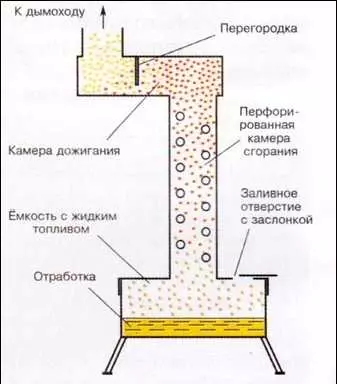
Furnace structure on spent oil with air supply pipe
The second way of separating the "heavy" fuel (oil of any origin) to "LEGORALLY" components are more efficient, but also more difficult in implementation. For effective evaporation in the bottom chamber, a metal bowl is installed. She is repelled, dropping drops on it instantly turns into volatile combustible couples. In this case, the glow is obtained (with the right mode) white-blue, as when burning plasma. From here it went another name for this design - with a plasma bowl.
In order to achieve the greatest efficiency of fuel combustion, the exhaust oil should be filled with very small portions to the lower chamber. In some embodiments, drops, sometimes - thin trickle. Therefore, they call this technology drip feed.
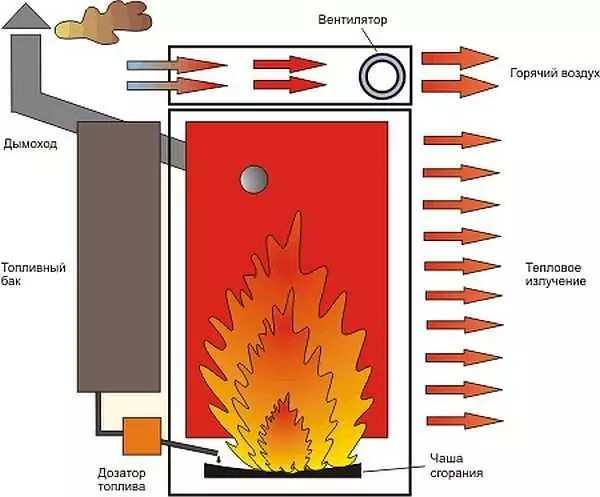
Principle of operation of the furnace on the exhaust oil with a plasma bowl
These are the basic principles of "action" of homemade heating units. There is a very large number of combinations and variations. Several of them are described below.
An example of the burning of testing in a plasma bowl you can see in the video below. This is the oven on the workout "Gecko", it has a built-in water heater and can work as a heating boiler.
Advantages and disadvantages
The main and main plus is that used fuel and oils are used, which otherwise were subject to disposal. In compliance with technology, the combustion is so complete that there are practically no harmful emissions into the atmosphere. The rest of the advantages are no less weighty:
- simple design;
- high efficiency;
- Low cost of equipment and fuel;
- works on any oils, organic, synthetic, vegetable origin;
- Allowed to 10% of pollutants.
Disadvantages are also serious. And the main thing is that when non-compliance with technology, the combustion of fuel is incomplete. And the couples fall into the room, and this is very dangerous. Therefore, the main and main requirement: furnaces working in exhaust oil are established exclusively into rooms with ventilation system.
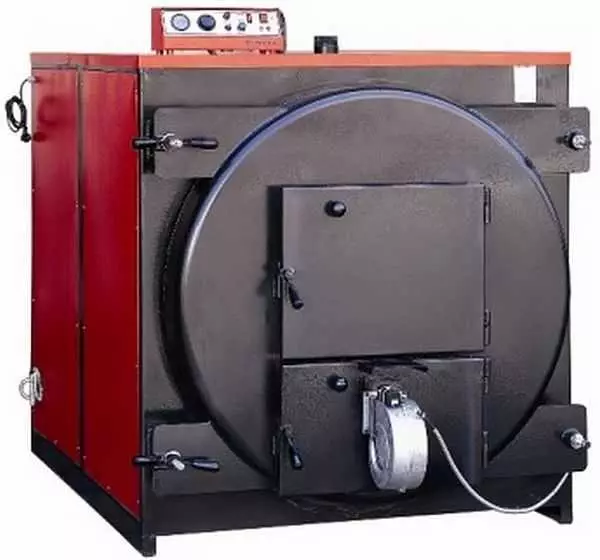
For comparison: this is a boiler on spent oil with an inflatable burner. The technology is different, as is the design (more in the video almost at the end of the article)
There are more minuses:
- To ensure good thrust, the chimney must be direct and high - at least 5 meters;
- Requires regular cleaning of the bowl and chimney - daily;
- Problem Rizhag: You need to split the bowl first, then apply fuel;
- Water-heating options are possible, but their independent design is a difficult task - it is impossible to strongly lower the temperature in the burning zone, otherwise the whole process will fall apart (as an option - install a water shirt to chimney, here it definitely does not prevent the decay of the fuel).
Article on the topic: Porcelain tile for the floor: dimensions, weight, thickness and laying; What is the difference between porcelain tiles from ceramic tiles?
Because of such features for the heating of residential buildings, such aggregates are rarely used. If they put them, then in separate rooms and in the final form.
Application area
In the basic performance, the homemade stove on the exhaust oil warms the air. They are also called thermal guns, heat generators or carriers. For the heating of residential premises, it is rarely used: the air is cut, oxygen from hot metal walls is burned. But to maintain normal temperatures in production or technical premises such aggregates are very effective: quickly raise the temperature. They can be seen on a hundred, car wash, in garages, production workshops, where there are no combustible materials, in warehouses, in greenhouses, etc.
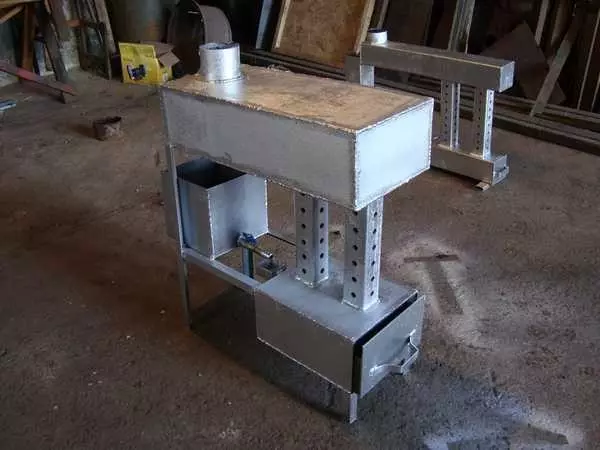
Ovens on working out with their own hands - for the garage is the best option
Many options can be finalized: they can install a coil to heating water or make a water shirt. Such equipment is already referred to the category of hot water and can be put in the water heating system. Without automation oven on working with water circuit requires constant control, but for cottages, host buildings with liverity, etc. This is an excellent option.
How to make the oven on the spent oil
Today there are no one dozen different designs. They use different methods for extracting thermal energy, have a different structure.Furnaces for burning tube
The furnace is easier if the hull is ready. As such, a gas or oxygen cylinder can be used, a thick-walled barrel or pipe. Below, the diagram explains how to make the stove on the spent oil from the pipe.
The work of this unit is based on evaporation in a plasma bowl. It can give up to 15 kW of heat (on average, it can heat up 150 squares of the area). Large heat transfer due to any changes (samples of a furnace or an increase in air supply) is impossible: the heat mode will break and instead of a larger amount of heat, a larger amount of chad is obtained, and this is unsafe.
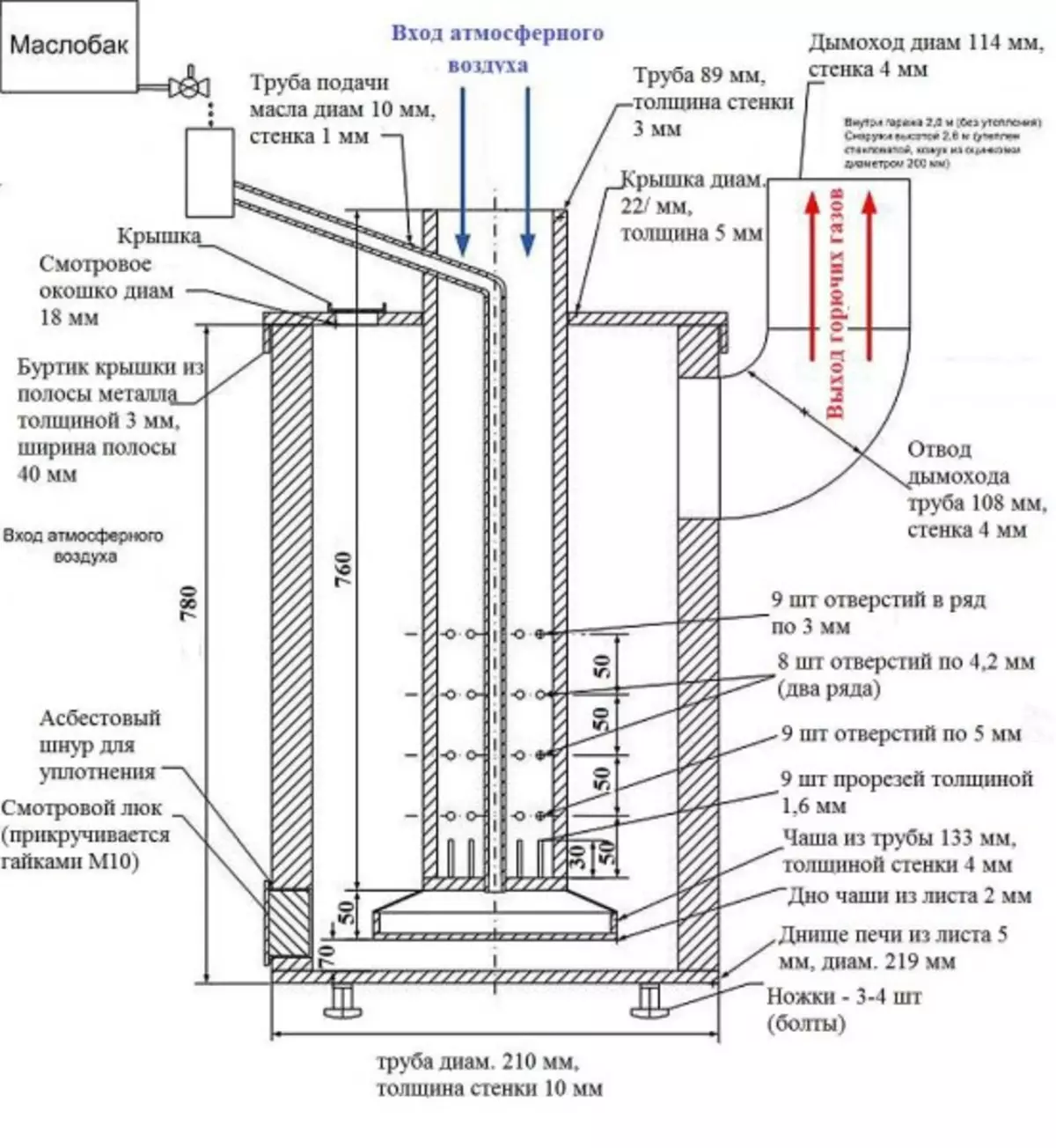
The oven on working out from the pipe can be made with your own hands in the presence of welding skills
The order of assembly is:
- Making the case.
- We take a thick-walled pipe with a diameter of 210 mm, the thickness of the wall is 10 mm. Height 780 mm.
- From sheet steel, a thickness of at least 5 mm is cutting with a bottom with a diameter of 219 mm and weld it on one side. This is the bottom.
- The bottoms are welded to the bottom (they can be made of bolts).
- At a distance of 70 mm from the bottom make a lookup window. Through it, it will be possible to track the burning and disperse the bowl on the "Start". Dimensions, respectively, make it convenient for you. The door itself is made from a carved piece of pipe, welding a thin bin. But everything should be closed hermetically, therefore, on the perimeter, the doors lay asbestos cord. You can use a stove casting, then the sizes of the hole are cut under it. It is possible to mount it on the bolts directly to the housing (asbestos cord is required and here).
- From the opposite side of the body, retreating from the top 7-10 cm, weld the pipe for the removal of flue gases. Its diameter is 108 mm, the wall thickness is 4 mm.
- Mastery lid.
- From metal with a thickness of 5 mm, a circle with a diameter of 228 mm is cut.
- Bill from the metal strip of 40 mm wide, the metal thickness is 3 mm.
- The opening of 89 mm with a diameter of 89 mm is cut into the center, the second with a diameter of 18 mm is cut from the side. A smaller hole serves as another viewing window, a cover is manufactured, which is used in combination as a safety valve.
- We make a pipe for air and fuel.
- Take a piece of pipe diameter 89 mm, with a wall thickness of 3 mm, 760 mm long.
- Rates from the edge of 50 mm around the circle, 9 holes of 5 mm in diameter drill.
- By 50 mm above these holes, two more rows of holes with a diameter of 4.2 mm are made, 8 pcs in each row.
- Rising even higher by 50 mm make the fourth row of 3 mm holes in diameter. There must be 9 pieces.
- From the same side, on the edge of the grinder cuts the slots with a thickness of 1.6 mm and a height of 30 mm. On the circumference of the pipe they need to do 9 pcs.
- From the other end of the pipe, retreating 5-7 mm cut the hole with a diameter of 10 mm.
- Insert the fuel supply pipe into the cut hole. Its diameter is 10 mm, the thickness of the wall is 1 mm. It ends on the same level with the air supply pipe. The length and angle of bend depends on where the fuel container will be located.
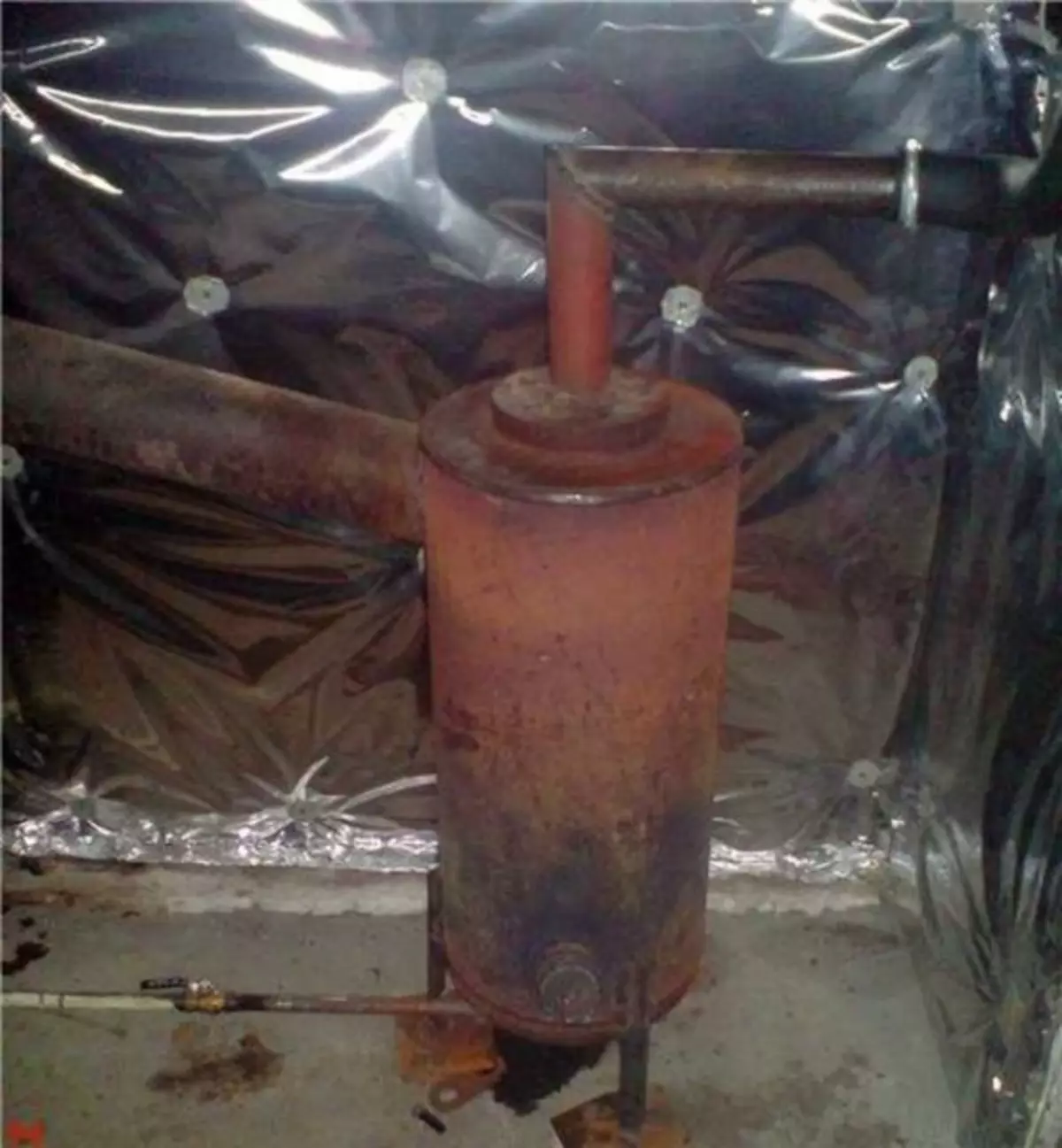
Example of a homemade stove from the pipe
- The finished pipe supply of air and fuel is welded to the lid. It is exhibited so that it does not take 120 mm to the bottom of the housing.
- We make a bowl for fuel
- Now from the pipe with a diameter of 133 mm, with a thickness of the wall 4 mm, a piece of 30 mm is cut off.
- Cut from sheet steel with a thickness of 2 mm circle with a diameter of 219 mm.
- We weld to pieces of pipe. It turned out a bowl where fuel is served.
- Assembly.
- Inside the case at a distance of 70 mm, a bowl is installed on the bottom. It will be possible to observe (and ignite) from the lower observation hatch.
- Install the cover with the fuel / air supply device.
- The chimney is installed on the flue nozzle. Pipe with a diameter of 114 mm, wall 4 mm. Its height is at least 4 meters. A part that remains indoors may not be isolated, on the street it is better to insulate. Chimney - only vertically up, inclined areas are excluded.
After installing the oil-tank, you can begin testing. At first, some paper is placed in the bowl, fuel fluid poured, everything is set on fire. After the paper almost burned, the oil supply opens.
This drawing of the furnace on the exhaust oil is not for nothing in vain with such an exact indication of the materials. It is necessary to use that such spare parts. As a result of the work of the self-made furnace, at a cost of 1-1.5 liters of fuel per hour, you can drop the room to 150 "squares".
Furnace drawing from a pipe or balloon in video format
The oven on spent oil from a cylinder (oxygen or gas) is represented by the author in video. The design is similar to the above described, but with original modifications (and it is a little simpler)Mini oven on working out with your own hands
This homemade stove with small size and weight (10 kg), the fuel consumption of about 0.5 lira per hour gives 5-6 kW of heat. It is possible to melt it stronger, but it is not necessary: it can explode. The design is loved by car enthusiasts: the garage is even in strong cold heats up quickly, oil spends economically, and even compact. Therefore, it can be called "garage".
The fuel tank of this small air cannon is assembled from the bottom and the tops of the standard 50-liter gas cylinder. It turns out a very reliable design (save at least one circular seam from the cylinder - there is a sealing ring, which will give greater strength. Make a reservoir from any other capacity of such dimensions: with a diameter of 200-400 mm and a height of about 350 mm.
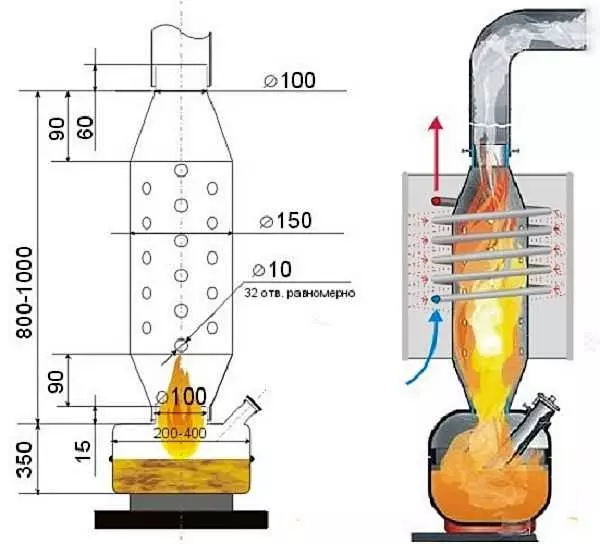
Little oven on working out, it weighs about 10 kg, with her hands it is easy to make it
In addition to the fuel tank, you need to make a pipe in which the fuel and air mixture is mixed. Wall thickness here at least 4 mm. You can use the tube of a suitable diameter. The cone is boiled from the structural steel not thinner than 4 mm.
The dimensions indicated in the drawing in the exhaust oil can be adjusted to a large or smaller side, but only 20 mm - no more. Especially carefully need to steer the seams in the places of funnels: here the fuel and air mixture is delayed for a long time, which is why the temperature is considerable.
The length of the chimney pipe is not more than 3.5 meters. Otherwise, because of too good thrust, fuel will pull into the pipe, which will significantly increase the flow rate and reduce the heat transfer.
The figure right shows the water-ham version of the self-made furnace. A few turns of the steel tube are made around the top of the Zone, which passes water. In order for the gases to not much fall, the coil closes the heat-refining casing of steel. Cold water is reduced from below, passing along the helix, heats up and goes into the system.
Miracle oven on working out
This option is very popular with summer houses and in garages. Comfortable small stove, which is done with round or square burning zones. The design is so successful that there are even industrial options. For example, one of the enterprises sells it entitled "Rice". The diagram is given all the necessary dimensions.
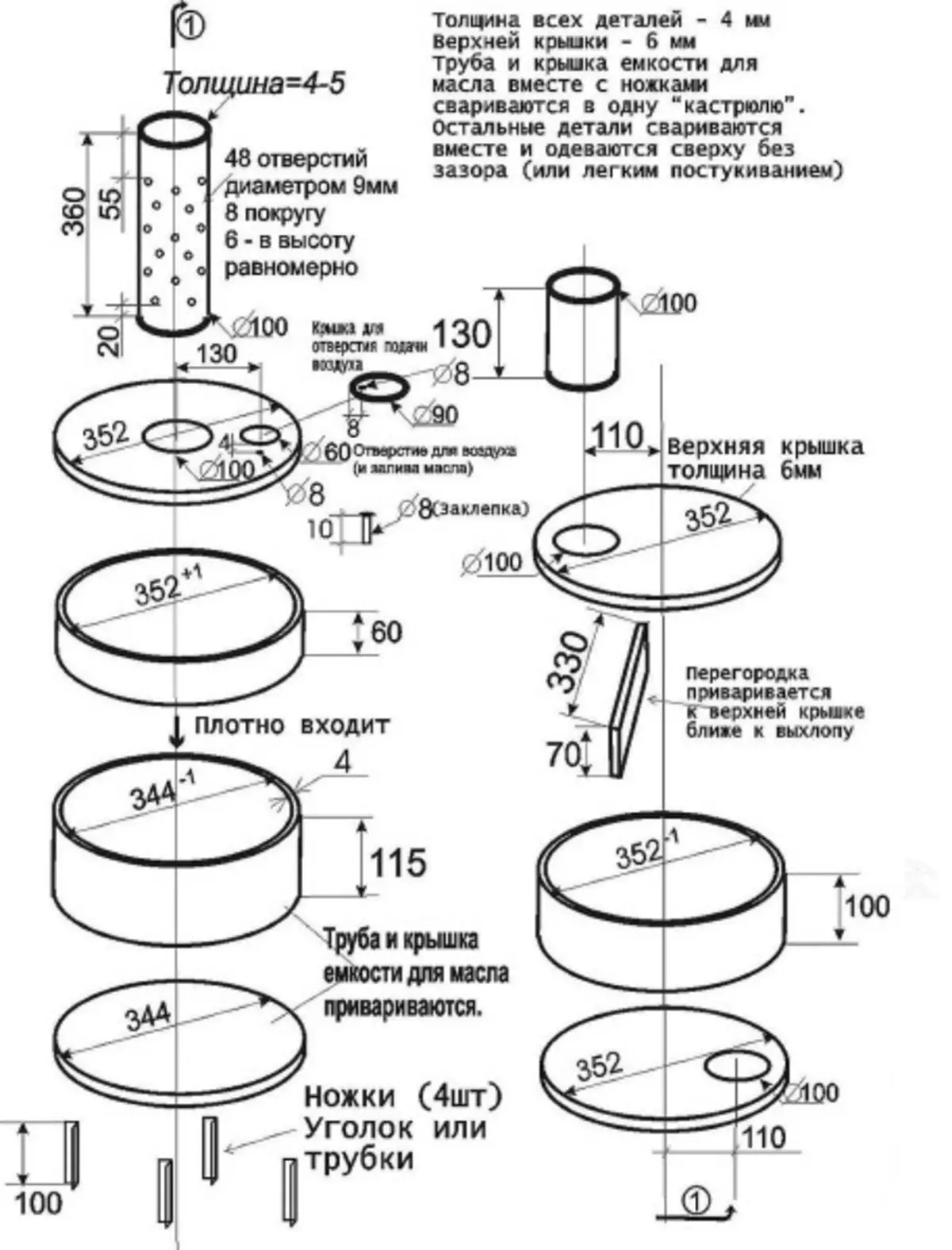
The scheme of the oven on the exhaust oil with dimensions - everything you need in order to make it yourself
Video report on how to collect this furnace will help navigate in the order of work.
The video below shows the option with square tanks, its refueling and sizes.
Factory options
Furnaces working in exhaust oil make not only the handicraft method, they are manufactured and industry. And there is both imported and Russian. But the type of construction is different.
European or American boilers on the workshop belong to the category of furnaces on liquid fuel. They use the principle of boost: oil is sprayed into small droplets, connects with air flow. And already the fuel and air mixture is set on fire. Importable factory ovens use the same principle, only a special burner is put, in which the fuel is heated before spraying.
To estimate the difference in technology and build, see the following video. The device is completely different.
In most Russian-made furnaces, the first principle is used - there is a hot (plasma) bowl in which liquid fuel is interrupted into gaseous, mixed with air and burned. This principle built the following aggregates:
- Gecko. Produced in Vladivostok. Make aggregates with a capacity of 15, 30, 50 and 100 kW / hour. These are water heating boilers, which are embedded in water heating system. Prices from 70,000 steering wheel for 15 kW boilers.
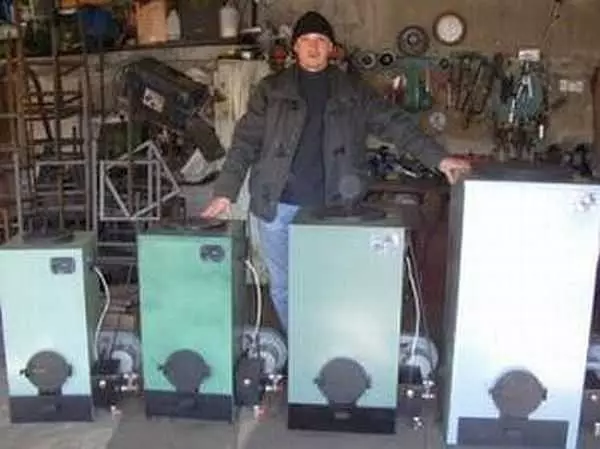
Boilers on the development of Russian production "Gecko"
- Typhoon. They are produced by the firm "Belamin". These are heat generators: air heats up. There are two options - Typhoon TM 15 and TGM 300, give 20-30 kW / hour (price: 45 000 rubles and 65,000 rubles, respectively).
- Christmas tree-turbo, there is 15 kW, there is 30 kW. These installations heat the air, but it is possible to make a water shirt.
- Heatlamos furnaces with a capacity of 5 kW / hour to 50 kW / hour. Refer to the discharge of heat guns (heating air). Start working from electrical heating plasma bowl, the fuel supply begins to achieve the desired temperature and the forced air supply is turned on into the combustion zone. The price of these settings is from 30,000 rubles for an aggregate with a capacity of 5-15 kW.
Drawings and schemes
Models of furnaces that use spent oil created quite a few. And below are several schemes that can push you on the idea, and the oven on working out with their own hands will be effective, economical and safe.
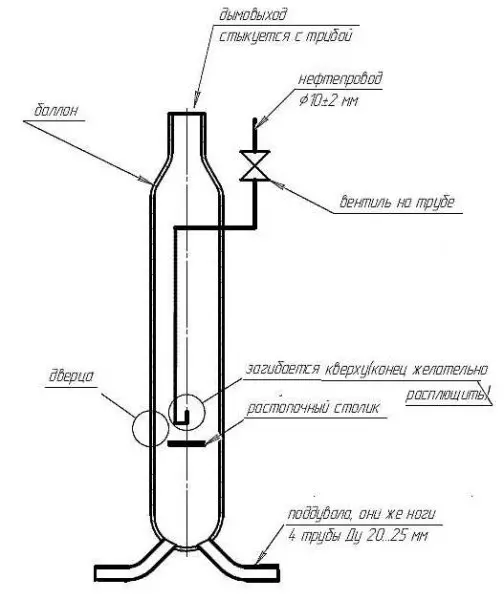
Oxygen cylinder oven
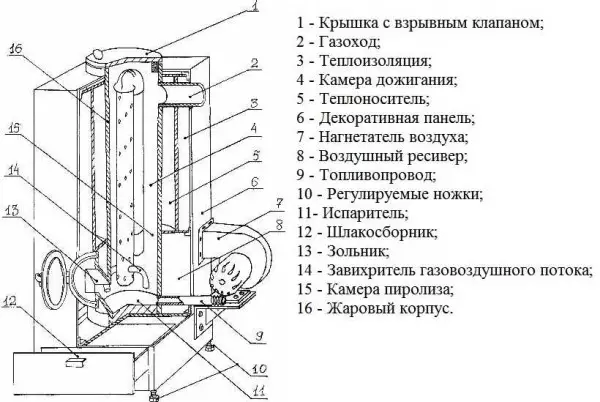
Scheme of the furnace "Gecko"
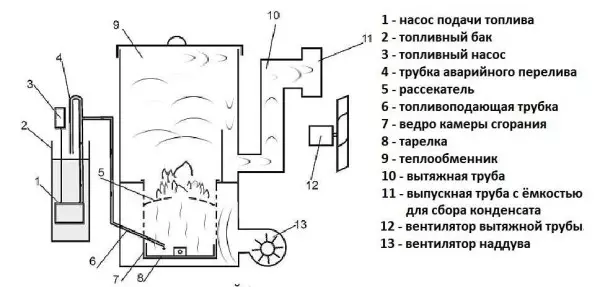
Stop on spent oil "Typhoon"
Article on the topic: Store things on the wall: Organizers, buckets, baskets and other storage ideas
